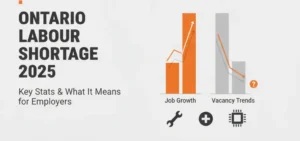Northern Ontario’s mining sector is still grappling with the mining industry labour shortage Ontario employers keep flagging. At a recent forum in Sudbury, government and industry leaders acknowledged that demand for skilled trades continues to outpace supply. Mechanics, electricians, millwrights, and heavy equipment technicians remain the hardest roles to fill — even as overall employment stays strong. For context, see CTV’s coverage: “Mining industry still dealing with labour shortage, Sudbury forum hears”.
In this article, we’ll break down why shortages persist, what they mean for mine operators and contractors, and how Ontario employers can act now. You’ll find actionable steps for talent attraction, apprenticeship, retention, and compliance – plus links to resources and Divino tools you can use today. For broader province-wide trends, review our analysis in Ontario’s Skilled Labour Gap: What Employers Need to Know.
Why the shortage persists in mining
Demographics and retirements. A large share of experienced tradespeople are nearing retirement. Mining has felt this acutely because many operations scaled up hiring during past commodity cycles, drawing in a cohort that is now exiting the workforce.
Training capacity and time-to-competency. Red Seal trades require significant on-the-job learning, and mines have unique safety and process requirements that extend ramp-up. You can’t compress hands-on time without risking safety.
Competition across sectors. Construction, manufacturing, and utilities compete for the same trades. When projects surge near urban centres, northern employers often lose candidates to shorter commutes or higher short-term pay.
Perception and mobility barriers. Younger workers sometimes view remote work sites as less attractive. Housing availability, transportation, and family supports can slow relocation decisions.
Regulatory and compliance changes. Employers must stay ahead of evolving rules that affect postings, onboarding, and pay transparency. This can stretch HR teams already focused on recruiting. For example, see Ontario Pay Transparency Rules Coming Jan 2026 and New Written Information Requirements for Ontario Employers.
What this means for operations and project delivery
Labour gaps hit three fronts:
- Production reliability: Unfilled maintenance roles raise downtime risk.
- Safety performance: Overreliance on overtime and short staffing can strain teams.
- Capital timelines: Expansion and modernization projects face delays without enough electricians, welders, and heavy equipment techs.
Because these impacts compound, leaders need a two-lane approach: immediate resourcing fixes and longer-term pipeline building.
Immediate actions to stabilise staffing
- Broaden your candidate pool – without sacrificing standards
Post beyond local markets and consider rotational schedules that reduce relocation friction. Offer relocation support or travel stipends for critical trades. Streamline selection to minimise time from interview to offer. When speed and compliance both matter, use an Employer of Record model where appropriate; here’s a primer: Employer of Record Ontario: A Small Business Guide and our dedicated service page: Employer of Record (EOR) Services in Ontario. - Activate apprenticeship pathways
Expand apprentice intakes and pair each apprentice with a strong journeyperson coach. Map rotations so new hires see multiple parts of the operation in year one. Leverage provincial supports to offset training costs – start with Financial supports for apprentices and sponsors and Hire or sponsor an apprentice. Build an intake calendar aligned to school terms so you’re always “recruiting ahead.” - Tighten your offer and onboarding
Publish clear pay bands and premiums for remote or high-skill roles, and show progression steps from day one. Pre-book medicals, security checks, and site orientations to cut start delays. Provide housing or short-term accommodations during the first 90 days when possible.
Strategic moves for the next 12–24 months
Strengthen local talent ecosystems
Partner with northern colleges, Indigenous training organisations, and community agencies. Offer site visits, scholarships, and guaranteed interviews for graduates. Position maintenance and electrical roles as modern, tech-enabled careers – not just “heavy industry jobs.” For policy context affecting candidate mobility, see Ontario’s new “As of Right” framework.
Recruit across provincial borders
As recognition frameworks evolve, plan for faster evaluation of out-of-province applicants. Standardise skill tests and safety orientation so external candidates can convert quickly once cleared.
Build an internal upskilling engine
Create pathways from general labour to trades apprenticeships. Subsidise pre-apprenticeship training and enable secondments that build hands-on hours. The goal is a farm system for mission-critical trades.
Modernise your EVP for remote and rotational work
Offer predictable rotations and flexible leave policies. Provide family travel support and community integration assistance. Invest in on-site amenities and connectivity. Be transparent about progression and competency-based pay.
Design for safety and wellbeing
Safety leadership is a recruiting tool. Show your near-miss learning process, technology investments, and mental health supports. Candidates ask about safety culture early – be ready with evidence.
Hiring messaging that resonates with trades talent
Your postings and outreach should answer three questions within seconds:
- What’s the work and what tools/tech will I use?
- How is the schedule structured and how often can I be home?
- What’s my path to higher tickets, premiums, or leadership?
Include a short “Day on Site” snapshot: start times, crew size, supervisor role, and key tasks. Pair it with a one-page progression map for each trade. Make sure the pay band and allowances are clear. For a cost planning lens, share or reference internal resources like How Much Does It Really Cost to Hire a Worker in Ontario?.
Compliance notes Ontario employers should keep in mind
Follow current requirements on candidate communications and posting transparency. Keep written job details aligned with provincial standards and site policies. Ensure apprentices are registered and supervised according to trade rules. To prepare hiring teams, review New Written Information Requirements for Ontario Employers and Ontario Pay Transparency Rules Coming Jan 2026.
Case for apprenticeships in mining: the numbers behind the strategy
Apprenticeships reduce time-to-competency while embedding safety culture early. Ontario offers milestone and training supports for eligible trades and sponsors. When you combine incentives with structured rotations, employers can reduce vacancy durations, stabilise maintenance schedules, and grow talent from within. Get started with Financial supports for apprentices and sponsors and the overview on Apprenticeship in Ontario.
Talent planning checklist for mine operators and contractors
Quarterly (next 90 days)
• Prioritise three trades with highest downtime impact.
• Launch a targeted campaign for each role with distinct EVP.
• Convert one general labour cohort into pre-apprentice roles.
• Pre-schedule medicals, orientations, and site passes for forecast hires.
• Review overtime and fatigue data; adjust rotations.
Bi-annually
• Sign MOUs with two colleges and one Indigenous training partner.
• Add a relocation/housing stipend for critical trades.
• Publish a pay progression chart for electricians and mechanics.
• Audit job ads for clarity and compliance. Update templates.
Annually
• Double apprentice seats in two priority trades.
• Add two cross-province recruiting partnerships.
• Benchmark safety culture and leadership training participation.
• Refresh your five-year workforce plan.
How Divino supports mining employers across Ontario
Divino specialises in recruitment, HR, and payroll solutions tailored to Ontario’s regulatory reality. We help mine operators and contractors fill urgent roles, build apprenticeship pipelines, and stay compliant as rules evolve. Explore our employer services hub: Recruitment & HR Services for Employers | Divino Ontario and industry-aligned support: Staffing by Industry.
• Recruitment & Staffing: Dedicated search for trades, maintenance, and technical roles.
• Employer of Record: Fast, compliant onboarding when timelines are tight – see EOR Services in Ontario.
• HR & Payroll: ESA-aligned policies, scheduling, and pay practices built for rotational work.
• Local reach: Find support near you via Ontario Locations.
For current legislative shifts that influence hiring, see our updates like Bill 192: What Employers Need to Know Now.
Bringing it back to Sudbury
Sudbury sits at the heart of Ontario’s mining economy. The forum’s message was clear: the labour shortage is still real, even with record employment numbers. For employers, the path forward blends immediate fixes with patient pipeline building. Those who design better rotations, invest in apprenticeships, and communicate career growth will win the next wave of trades talent. Read the original report from CTV: “Mining industry still dealing with labour shortage, Sudbury forum hears”.
Ready to act?
Divino can help you stabilise today’s operations and build tomorrow’s workforce. Book a Free Staffing Consultation to get started.



